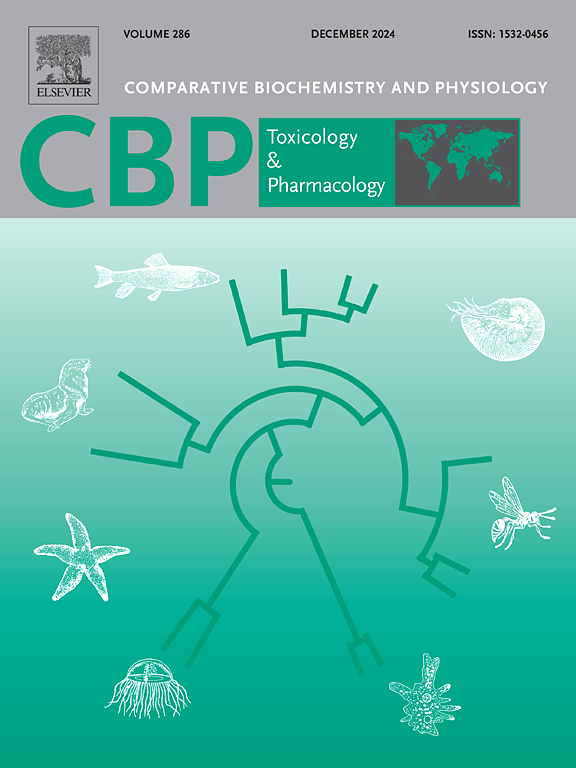喹诺芬1995-2019是故事的结局吗?评估其对头大小和参与突触成熟的神经系统基因的不利影响。
IF 4.3
3区 环境科学与生态学
Q2 BIOCHEMISTRY & MOLECULAR BIOLOGY
Comparative Biochemistry and Physiology C-toxicology & Pharmacology
Pub Date : 2025-06-16
DOI:10.1016/j.cbpc.2025.110252
引用次数: 0
摘要
2013年,喹诺芬(QXY)因其对水生生物的毒性被列入欧洲水框架指令的优先危害污染物清单。自2019年6月27日起,禁止在所有广告中使用含有QXY的产品。QXY是一种具有潜在持久性、生物蓄积性的有机污染物,不容忽视。迄今为止,这种化合物对发育的影响尚不完全清楚,因此本研究试图阐明QXY对斑马鱼发育的不利影响。本研究旨在以斑马鱼为体内模型,进行毒理学和分子研究,了解QXY的毒理学效应。考虑到FET试验结果,我们选择了0.4 mg/L和0.8 mg/L两个亚致死浓度进行后续分析。评估gad1b、cyp19a1b、shank3a、nrxn1a和c-fos基因的表达,这些基因参与神经系统的发育和突触传递的调节。为了证实该处理对中枢神经系统发育的潜在神经毒性作用,我们使用转基因Tg(neuroD:gfp ia50)系进行共聚焦显微镜观察,并使用橙吖啶对野生型幼虫进行观察,以评估神经元凋亡的存在。结果显示亚致死改变,特别是影响颅面和大脑发育,突出显示QXY可能代表一种可能的内分泌干扰物,能够在斑马鱼幼虫中诱导严重的软骨缺陷,小头和震颤表型,并对所选基因进行强烈调节。本文章由计算机程序翻译,如有差异,请以英文原文为准。

Quinoxyfen 1995-2019 is the story's end? Evaluation of its adverse effects on head size and nervous system genes involved in synaptic maturation
In 2013 quinoxyfen (QXY) was included in the list of priority hazard pollutants of the European Water Framework Directive due to its toxicity to aquatic organisms. The use of products formulated containing QXY was banned from all commercials starting from 27th June of 2019. QXY is an organic pollutant with potential persistence, bioaccumulation and this must not lower attention to this pollutant. To date the effects of this compound on development are not completely clear, thus this research tries to elucidate the adverse effects of QXY on zebrafish development. The study aims to understand the toxicological effects of QXY using the zebrafish as in vivo model and performing toxicological and molecular investigations. Considering the FET test results two sublethal concentrations, 0.4 mg/L and 0.8 mg/L were chosen for subsequent analysis. The expression of the gad1b, cyp19a1b, shank3a, nrxn1a and c-fos genes, involved in the development of the nervous system and the regulation of synaptic transmission, were evaluated. To confirm the potential neurotoxic effects of the treatment on the development of the central nervous system, both a transgenic Tg(neuroD:gfp ia50) line was used for confocal microscopy and Orange Acridine was used on wild type larvae to assess the presence of neuronal apoptosis. The results showed sub-lethal alterations, particularly affecting craniofacial and brain development highlighting as QXY may represent a possible endocrine disruptor able to induce severe cartilage defects, small head and tremor phenotype in zebrafish larvae and a strong modulation of the selected genes.
求助全文
通过发布文献求助,成功后即可免费获取论文全文。
去求助
来源期刊
CiteScore
7.50
自引率
5.10%
发文量
206
审稿时长
30 days
期刊介绍:
Part C: Toxicology and Pharmacology. This journal is concerned with chemical and drug action at different levels of organization, biotransformation of xenobiotics, mechanisms of toxicity, including reactive oxygen species and carcinogenesis, endocrine disruptors, natural products chemistry, and signal transduction with a molecular approach to these fields.

 求助内容:
求助内容: 应助结果提醒方式:
应助结果提醒方式:


